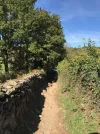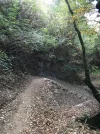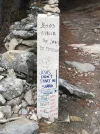We just finished from Sarria to SdC with my 82 year old Grandfather (with a replaced hip, titanium heart valve, COPD, etc). We took 21 days and starting out walking 4-8km a day. After he developed a terrible chest infection and we had to essentially carry him for part of a day, we rented a wheelchair and pushed/pulled him from Arzua. There are places to stay alllll along the route from Sarria--we booked the day before so we knew were we were headed and took a taxi once, from O Coto to Melide (and then back the next day to finish the walk to Melide). There's actually a nice looking private place in O Coto though, so totally doable without the taxi if you are staying in pensions as well.
As others have said, the stairs I remember are leaving Sarria, up to Portomarin, and then down to the cathedral right at the very end. Also in the Albergue Seminorio de Menor in SdC. Stairs for days.
It's a bit of a trek from the main route, but Camino das Ocas has an accessible washroom with a ground floor room and a very friendly proprietor. Many of the albergues we stayed in (usually private ones, but not pensions, they were dorms) did have 1/2 or a flight of stairs to get up to the sleeping area, but wherever possible they gave at least my grandfather a same-level room. Our route (I don't think too many people do it with so many stages and I didn't see much about it, so I'll post it in the hopes it may be helpful when finding places to stay) was:
• Sarria-Barbadelo (4km)
• Barbadelo-Morgade (8.5km)
• Morgade-Mercadoiro (5ish)
• Portomarin (5.5) *rest day*
• Ortiz (8.7)
• Ventas de Naron (4.4)
• Ligonde (3.6--I think we did such a short day because of where the Albergues were located)
• Palais de Rei (8.34--there are a couple of other albegues in the Ventas-Palais area, but we couldn't book them or they were closed, which is why we had the short + long day) *rest day*
• Casa Domingo (just past St Xulian) 4.7km
• St. Xulien to O Coto (4.2), taxi to Melide
• taxi back to O Coto, walk to Melide 6.33km
• Boente (6.12)
• Milpes (Ribadaiso) 6.33km
• Arzua (2.46km--super short but Grampa needed a break at that point) *rest day*
<<this is where we rented the chair, so we started to be a bit faster>>
• Camino Das Ocas (4.37)
• Salceda (6.67)
• O Pedrouzo (9.5)
• Lavacolla (11.61)
• Seminorio de Menor (edge of Santiago) (11.16) <<there were a LOT of stairs here and no lift...
• Cathedral (1.36)
Have a great time! We were past by just about everyone and missed the chance to meet people repeatedly or form any kind of 'Camino Family', but on the other hand we loved seeing soooo much as we walked and really having time to enjoy the experience, each other, and a solid 4-6 cafe con leches per day




















